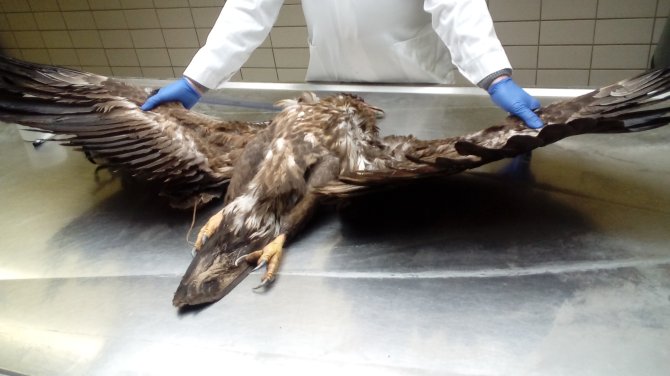
News
WUR research shows: Poison overdose kills white-tailed eagle
Researcher Peter van Tulden of Wageningen Bioveterinary Research (WBVR), part of Wageningen University & Research (WUR), investigates wild animals found dead under suspicious circumstances. Together with colleagues from other WUR units, he recently traced the cause of death of a white-tailed eagle. “The animal had died from an overdose of poison,” Van Tulden said. “Unfortunately, the white-tailed eagle was not the first victim. Poisonings are something we encounter on a regular basis.”
Transmitter
White-tailed eagles are fairly unique in the Netherlands. Several breeding pairs have been present again in the past years. The Netherlands White-tailed Eagle Working Group keeps a close eye on the population, partly by fitting the animals with a transmitter. The white-tailed eagle that feasted on a dead coot in a Frisian meadow also wore a transmitter. Not long after catching its prey, the working group members noticed that the white-tailed eagle did not change its position and that its life signals were alarming. The white-tailed eagle was found dead in the field; the animal had fallen forward onto the coot.
Predator and prey
Both the white-tailed eagle and the dead coot were presented to WBVR for research. “It is quite unique for not only the dead animal, but also the prey to come in for examination,” says researcher Van Tulden. As part of the Statutory Investigation Tasks (WOT) assigned to WBVR for the Ministry of Agriculture, Nature and Food Quality, the investigation into the cause of death begins at the autopsy room in Lelystad.
Examination
Van Tulden first examines the animal externally. “We first want to know if there are any injuries or damage that could be a clue to the cause of death,” he says. After the external examination, autopsy follows. Here he focuses particularly on the organs. He looks at colour, filling and abnormalities. This is followed by sampling. In birds, a sample of beak and cloaca is a standard procedure. “We check all wild birds for the presence of bird flu virus,” he says.

Samples
The white-tailed eagle came in with a bite of the coot in its beak. Both the coot and the contents of the eagle's crop and stomach were sampled. “Those samples were sent to colleagues at Wageningen Food Safety Research in Wageningen. They can do a general screening for toxins in the samples,” Van Tulden says. The screening at WFSR showed the presence of alpha-chloralose. “And not just a little, either. The white-tailed eagle died from an overdose of poison,” Van Tulden concludes. “The amounts used were so high that the animal dropped dead on the spot, on top of its prey.”
Poisoning
Van Tulden is convinced that the coot was deliberately treated with the poison to kill a prey animal. “Presumably the target of the action was not the white-tailed eagle, but another scavenger such as a fox that could have preyed on the coot. In this case, it was a tagged white-tailed eagle who took the bait and cause and effect were easily linked.” In the past, Van Tulden encountered such poisoning, even with this specific drug, more often; in the last decade, it had actually disappeared from the radar. “After this type of poison was banned, we also saw it less in top predators such as birds of prey. Recently, the rules have changed and alpha-chloralose now is the active ingredient in 'new' products to control mice and rats.”
Not unique
The Netherlands White-tailed Eagle Working Group has filed a report. That means the police are investigating the incident. Van Tulden expects that the white-tailed eagle is certainly not the last case of poisoning he will receive in the autopsy room this year. “Poisonings of wildlife occur regularly. We by no means see all cases, partly because today there are far fewer people with knowledge and authority walking in the field. The number of reports has decreased as a result,” Van Tulden says. According to him, that does not mean that the number of poisonings has also decreased. “The fact that we find a wide range of agents in the raptors that we analyse says it all.”